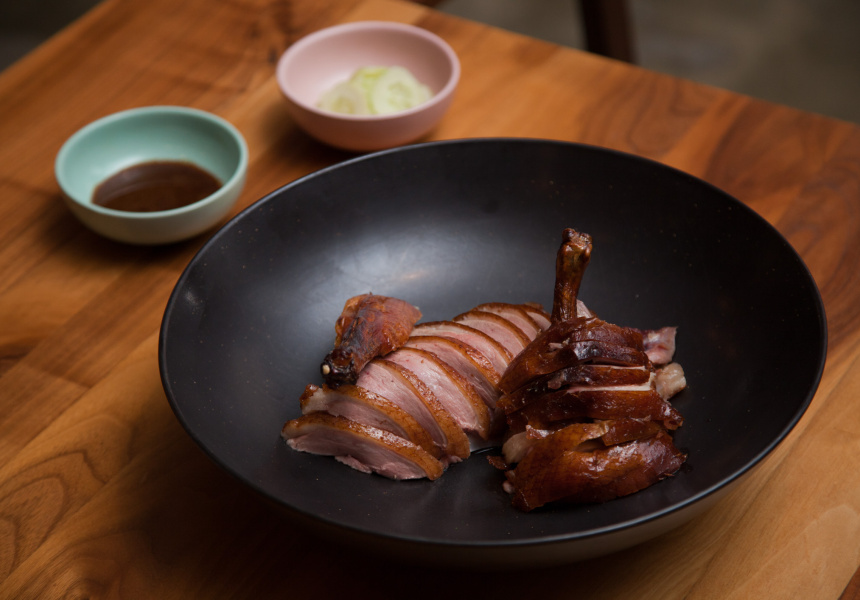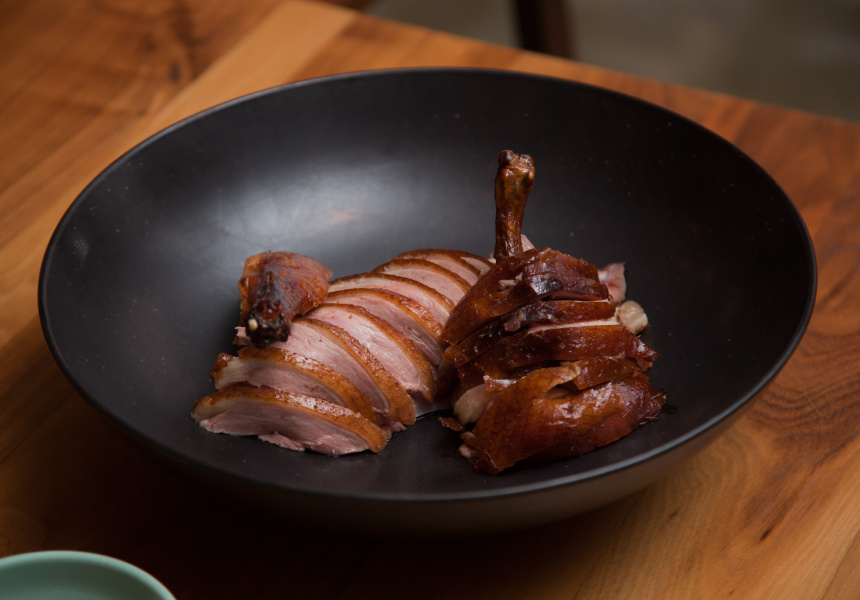You may see them hanging in the window of countless Chinese restaurants, but making one yourself is not as simple as marinate and hope for the best. There’s a true art to getting the seasoning right and allowing it to permeate every part of the meat, as Brenden Gradidge, head chef (under executive chef Ryan Squires) at Brisbane’s much-lauded Esquire and Esq. explains.
“The duck kind of developed out of the fact that I didn’t always like what I found in Chinatown – they could be over cooked, or too sweet, or the skin wasn’t crispy,” says Gradidge, of developing the Esquire version. “Those are the things we aim to perfect. The stuffing has to be really strong to season the meat, but not completely overpowering. And the crispy skin comes down to the blanching and air-drying of the duck.”
The whole process of stretching and air-drying the skin can take up to a week at Esquire, including hanging the duck in the fridge for several days. But the seasoning and blanching is a crucial step towards that perfect flavour.
Never miss a Sydney moment. Make sure you're subscribed to our newsletter today.
SUBSCRIBE NOW“We use a stuffing of hoisin sauce, white pepper, ginger, garlic, five-spice, salt, sugar and licorice root in the cavity,” says Gradidge. “We put it together from trying flavours that we like in Peking Duck and what we like when you eat duck pancakes. It’s all flavours we’re familiar with.”
But once the inside is taken care of, there’s still the outside to sort out for the full effect.
“After you’ve stuffed the bird, you blanch it in a mix of water, licorice root, lemon juice and maltose – which is a sugar the Chinese use for Peking Duck – and a little bit of vinegar. That softens the skin and breaks it down, and adds the sugar content.” It also gets the whole seasoning process on the go. The trickiest part according to the chef is initially separating and stretching the skin away from the meat – a technique that involves using a hand pump or creaming canister to blow the duck up like a balloon. Nothing is inserted under the skin, but if it’s done properly, with no breaks and a small incision in the skin, the fat will render and stop the skin from cracking in the cooking process.
You don’t have to go the whole hog at home (and let’s face it, who’s got the space or the opportunity to hang a ballooned-up duck in the fridge for a week) but here’s the full version in case you want to give it a go, as well as all the details to get the seasoning and blanching just right – and the seasoned juices from the cavity of the cooked duck are the perfect finishing touch to the roast bird.
What you’ll need
1 duck – Gradidge uses ducks from the Macedon Ranges in Victoria
A mortar and pestle
A large pot – big enough to fit your duck in for blanching
Hand pump – you can use a bicycle pump or an empty creaming canister/gun charged twice
Kitchen needle and twine to close the stuffed duck – you can use a skewer
Space in a large fridge with a fan to hang and dry the duck
Seasoning stuffing ingredients
40g roughly ground white pepper
100g hoisin sauce
10g flaked sea salt
15g caster sugar
1tsp five-spice powder
2 slices fresh ginger
3 cloves crushed garlic
2 pieces dried licorice root
Blanching ingredients
100ml cooking vinegar
Juice of 2 lemons
500g maltose (you’ll find this at any Asian grocer)
2 pieces of licorice root.
Method
Remove the wing tips of the duck by cutting through the joint. Discard.
Separate the skin from the meat of the duck. Do this by placing the needle tip of the bike pump underneath the skin somewhere near the wishbone and pump it until the skin slowly comes away form the meat. Continue this until it is pumped up like a balloon.
Using the mortar and pestle, crush up the seasoning stuffing ingredients and mix it together really well. It should taste heavily seasoned – almost unpleasantly so. This will be used to season the meat and will not be eaten.
Place this mix into the cavity of the bird.
Sew up the cavity to secure it shut.
Bring 5 litres of water to the boil in the large pot with all the blanching ingredients.
Drop the duck into the water and blanch for 30 seconds each side. Remove
Hang it in a fridge closest to the fan for a minimum of two days, but for up to five days.
Pre-heat oven to 200°C and place the duck in a rack in the oven and roast, rotating every 10 minutes. Cook for 30–35 minutes until golden brown.
Rest for the duck for at least an hour to retain the juices.
Cut the duck and strain any juices that come out from the cavity to pour over when serving.


